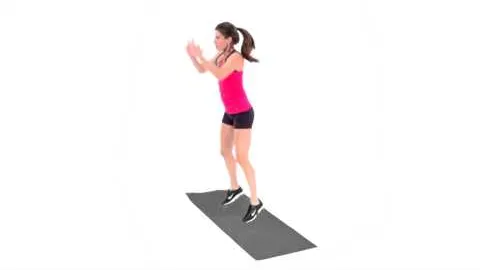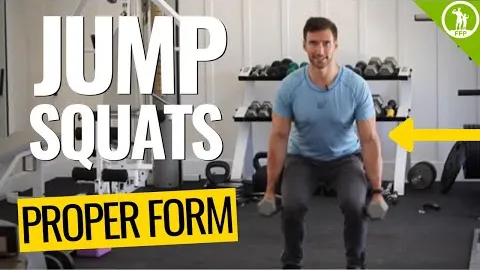

If you're looking to enhance your lower body strength, improve athletic performance, and increase explosiveness, then incorporating jump squats into your workout routine is a must. As a compound exercise that targets multiple muscle groups simultaneously, jump squats offer a variety of benefits, including increasing power, improving agility, and boosting cardiovascular fitness. In this article, we will delve into the mechanics of jump squats, discuss their many advantages, and provide step-by-step instructions on how to perform this dynamic exercise correctly.
Jump squats can be considered a combination of two foundational exercises - squats and vertical jumps. By blending elements of both movements into one exercise, jump squats engage various muscle groups and train them to work together synergistically. Here's a breakdown of how jump squats work:
Begin by standing with your feet shoulder-width apart, ensuring your knees are slightly bent. Maintain a straight posture, with your core engaged and shoulders pulled back.
Initiate the movement by lowering your hips back and down as if you were sitting into an imaginary chair. Keep your weight centered over your heels, and make sure your knees stay aligned with your toes. Continue to descend until your thighs are parallel to the ground, or as low as you can comfortably go without compromising form.
From the bottom position of the squat, quickly reverse the motion and explode upwards into the air. Extend your ankles, knees, and hips simultaneously to propel yourself off the ground. As you jump, swing your arms overhead for added momentum.
Land softly on the balls of your feet, simultaneously bending your knees to absorb the impact. Aim for a seamless transition from the jump to landing, ensuring your knees and hips remain flexed to minimize stress on your joints.
Strength Building: Jump squats primarily target the lower body, including the quadriceps, hamstrings, glutes, and calves. By repeatedly performing this exercise, you can effectively build muscle mass, increase strength, and improve muscular endurance in your lower limbs.
Power Development: The explosive nature of jump squats engages fast-twitch muscle fibers, which are responsible for generating high levels of force and power. By focusing on producing maximum force during the jump phase, you can enhance your power output, which is crucial for activities like sprinting, jumping, and explosive movements commonly seen in many sports.
Improved Athletic Performance: Jump squats are considered a functional exercise due to their ability to simulate movements found in various athletic activities. By replicating the explosive nature of movements such as jumping, tackling, or changing direction quickly, jump squats can improve your overall athletic performance.
Enhanced Vertical Jump: Vertical jump height is a measure of lower body power and explosiveness. Regularly incorporating jump squats into your training routine can lead to significant improvements in your ability to jump higher, making it a valuable exercise for athletes involved in basketball, volleyball, or any sport that requires jumping ability.
Burns Calories and Boosts Cardiovascular Fitness: Jump squats involve multiple muscle groups and require significant energy expenditure. As a result, this exercise helps burn calories and contributes to cardiovascular fitness improvement.
To reap the benefits of jump squats and avoid injuries, proper form is essential. Follow these step-by-step instructions to perform jump squats correctly:
Begin by standing with your feet shoulder-width apart, toes pointing slightly outward.
Lower your hips down and back, keeping your chest up and back straight. Squat until your thighs are parallel to the ground, or lower if you can maintain proper form.
From the bottom position, forcefully jump upwards, fully extending your ankles, knees, and hips. Swing your arms overhead to generate momentum.
Land softly on the balls of your feet, bending your knees to absorb the impact. Ensure your knees remain aligned with your toes to prevent excessive stress on your joints.
Complete the desired number of repetitions, gradually increasing the intensity and difficulty over time.
While jump squats offer numerous benefits, it is crucial to perform them safely and mindfully. Consider the following precautions and modifications:
Jump squats are a highly effective exercise for building lower body strength, enhancing power, and improving athletic performance. By incorporating jump squats into your workout routine, you can take your fitness journey to new heights. Remember to prioritize proper form, increase intensity gradually, and listen to your body to maximize the benefits while minimizing the risk of injury. So, lace-up your shoes, find a suitable space, and start incorporating jump squats into your training for explosive results.
If you're looking for a gym, fitness club or yoga studio, you've come to the right place.
You can find information about gyms in your area. Browse catalog of gyms and find gyms with classes which are you looking for.
On gym page you can find simple information like address, phone or website. You can find list of available classes. You can check availability of personal training or small group classes. On place page you can also see information about open hours.
You can find gyms near you with amenities, courts, studios and equipments.
Use our map to find gym at your city or district.
In Gym Navigator you can find list of exercises with movies for many body parts.
You can browse exercises catalog and find exercises the best of you.
You can also find exercises grouped into workout plans, which you can use to improve you body. Each routine show you exercises one by one and give you possibility to count you progress and count down rest time.